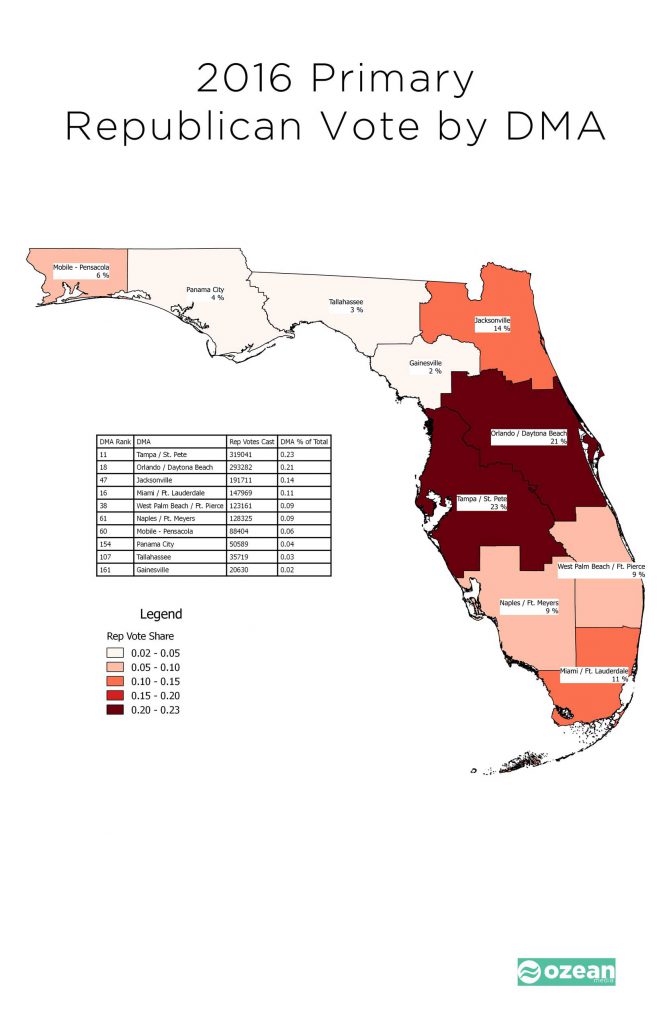
by Alex Patton | Sep 21, 2017 | Political Media
Admittedly, I have been slacking in writing. This is due to workload and frankly falling off the writing wagon.
I will try and do better, but in the meantime, I was asked to look at Republican Turnout in Florida. I only explored those voters currently registered in Florida that voted in the 2016 primary.
I only explored those voters currently registered in Florida that voted in the 2016 primary.
I chose to look at the turnout by Florida DMA – and you see the critical nature of the heralded I-4 corridor. Nearly 1 out of every 2 Republican primary votes came from the Tampa/Orlando DMAs. On the flip side, there is the poor old Gainesville DMA. (No wonder we are ignored and don’t get to see many cool TV commercials.)
Next on tap is to project the anticipated turnout for 2018 – that is a little more involved and not for publication.
Until next time, enjoy!


by Alex Patton | Dec 18, 2013 | Political Media
To begin, I need you to think of the most stereotypical politician you can. Yes, we are talking three piece suit, monocle, the whole 9 yards.
Kinda like this guy:

This is the guy that asked for a meeting with me yesterday. It was a great meeting….until the walk to the door.
I have friends who are doctors, and they have continuously warned me about the walk to the door accompanied by the “oh, one more thing doc…..”
The one more thing? “and, by the way, I want a digital campaign that will go viral.”

My reaction to a request for a “viral” digital
media campaign
DAMN IT! DAMN IT! DAMN IT!
I haven’t lost it this badly since the request for big data.
Besides my cynical problems with authority, I get a little flabbergasted when people take flippantly very complicated concepts, especially things we do as political consultants.
In an attempt to be more patient, please allow me explain myself.
The Science of Going Viral
Besides Gladwell’s The Tipping Point, there are two main books to look at when attempting to understand why and how things “go viral”:
Made to Stick by Chip & Dan Heath
Contagious by Jonah Berger
If we look at Heaths’ 6 principles:
- Principle 1 – Simplicity – an idea stripped to its core.
- Principle 2 – Unexpectedness – we must generate interest and curiosity
- Principle 3 – Concreteness – sticky ideas are full of concrete images
- Principle 4 – Credibility –
- Principle 5 – Emotions – we must make them feel something
- Principle 6 – Stories – we tell stories
If we look at Jonah’s 6 principles:
- Principle 1 – Social Currency – How does it make one look to talk or share?
- Principle 2 – Triggers – what trigger are we going to use?
- Principle 3 – Emotion – some emotions increase sharing, others actually decrease it.
- Principle 4 – Public – can we see others engaging in our desired behavior?
- Principle 5 – Practical Value – How can we craft content that seems useful?
- Principle 6 – Stories – What broader narrative can we wrap our idea in?
“There are six principles of contagiousness: products or ideas that contain Social Currency and are Triggered, Emotional, Public, Practically Valuable, and wrapped into Stories.” (Contagious, Berger)
So as we can see, there is a bit of actual science and heavy lifting that goes into creating a viral video. It is no flippant matter.
I would highly recommend reading all three books, but Heath sums up the main issue we have with politicians & their desire to “go viral.”
As Heath writes, “The most basic way to get someone’s attention is this: Break a pattern.”
According to Alex Patton’s Grand Unified Theory of Political Communication, in order to get a voters attention in this fragmented, cluttered world – we must be novel or shocking (break a pattern).
Immediately, we run into issues with a stereotypical politician’s request to “go viral” !
The Risk Tolerance of Politicians
If you have done any work with politicians, you will find the most risk adverse set of clients you will ever come across.
Let’s think back to our stereotype.
Do you think that guy’s natural inclination is to take wild risks and break patterns?
Getting a politician or candidate to agree to even explore the fundamental requirement of going viral is extremely difficult, at best.
Political Positive Deviance – Going Viral
Let’s search out some positive deviance to learn from specifically from the political world:
A Google search of “Political Viral Videos” is illuminating:
Politico: 10 best viral political videos of 2012
Why is is illuminating? In the top 2012 videos – not a single one of them was made deliberately by a politician. Yes, several of them star politicians, but none of them were designed or created by a politician. NOT ONE.
There are two three examples that I can recall off the top of my head of politicians purposefully creating ads that went viral. They also happen to be some of my favorite ads:
We are Better that that! – Dale Peterson
Demon Sheep Ad
We may even include a third:
Pigs – Ted Yoho
What do all of these have in common?
The candidates were desperate enough to take risks.
I’ve spoken with the gentleman that created the Demon Sheep ad, and they were desperate to change the conversation at the time of the ad.
Dale Peterson had little money, little name ID and was most likely going to get creamed. What did he have to lose?
Ted Yoho was running against a 27 year incumbent in a Congressional primary and did not nearly have the resources available to him. At the time of the ad, according to what polls you believe, he was down 5-9 points.
Again, ALL DESPERATE enough to take risks and break patterns.
Interestingly, when you study risk & human behavior, humans become MUCH less risk adverse when they “have nothing to lose.”
Conclusion
There is a point to this post.
In every case in which our firm has won national recognition, it was because a client was willing or desperate enough to take risks.
There is something about having your back to the wall.
The problem with risk? We may fail. And as we all know, when one fails on the Internet, one fails for all of mankind to witness and share.
So, before you flippantly request your political consultant to make you a digital media campaign that will go viral, you need to assess your tolerance for risk.
Because, the only way to make a video of your talking head tax presentation ‘go viral’ may be to loosen the screws in your chair so that it collapses ending in an uninterrupted stream of your cussing while a cat slinks by to close the video.
PS Finally, IF we are lucky enough to strike gold and have something go viral, we may want to discuss the value to your campaign of getting 100,000 karma on reddit and 1,000,000 you tube views comprising of people outside your voting district. (but that is another post)






